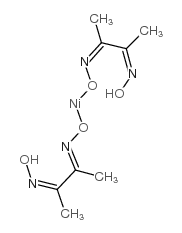13478-93-8
| 中文名 | 丁二酮肟镍 |
|---|---|
| 英文名 | nickel dimethylglyoxime |
| 中文别名 | 二甲基乙二肟镍 |
| 英文别名 |
NICKEL(II) DIMETHYLGLYOXIME
Bis(dimethylglyoxime)nickel EINECS 236-782-7 bis(butanedione dioximato)nickel Nickel dimethylglyoximate Bis(2,3-butanedione dioximato)nickel Bis(dimethylglyoximato)nickel (II) MFCD00136028 Bis(dimethylglyoximato)nickel Nickel dimethylglyoxime |
| 沸点 | 192ºC at 760mmHg |
|---|---|
| 熔点 | 250ºC (subl.) |
| 分子式 | C8H14N4NiO4 |
| 分子量 | 288.91500 |
| 闪点 | 69.9ºC |
| 精确质量 | 288.03700 |
| PSA | 108.36000 |
| LogP | 1.38660 |
| 蒸汽压 | 0.134mmHg at 25°C |
| 储存条件 | 常温密闭,阴凉通风干燥 |
| 稳定性 | 常温常压下稳定 避免的物料 氧化剂 |
| 分子结构 | 1、摩尔折射率:无可用的 2、摩尔体积(cm3/mol):无可用的 3、等张比容(90.2K):无可用的 4、表面张力(dyne/cm):无可用的 5、介电常数:无可用的 6、极化率(10-24cm3):无可用的 7、单一同位素质量:288.036854 Da 8、标称质量:288 Da 9、平均质量:288.9146 Da |
| 计算化学 | 1、 氢键供体数量:4 2、 氢键受体数量:8 3、 可旋转化学键数量:2 4、 互变异构体数量:10 5、 拓扑分子极性表面积(TPSA):123 6、 重原子数量:17 7、 表面电荷:0 8、 复杂度:119 9、 同位素原子数量:0 10、 确定原子立构中心数量:0 11、 不确定原子立构中心数量:0 12、 确定化学键立构中心数量:2 13、 不确定化学键立构中心数量:0 14、 共价键单元数量:3 |
| 更多 | 1. 性状:粉末 2. 密度(g/mL,25/4℃):未确定 3. 相对蒸汽密度(g/mL,空气=1):未确定 4. 熔点(ºC):未确定 5. 沸点(ºC,常压):未确定 6. 沸点(ºC,5.2kPa):未确定 7. 折射率:未确定 8. 闪点(ºC):未确定 9. 比旋光度(º):未确定 10. 自燃点或引燃温度(ºC):不适用的 11. 蒸气压(kPa,25ºC):未确定 12. 饱和蒸气压(kPa,60ºC):未确定 13. 燃烧热(KJ/mol):未确定 14. 临界温度(ºC):未确定 15. 临界压力(KPa):未确定 16. 油水(辛醇/水)分配系数的对数值:未确定 17. 爆炸上限(%,V/V):未确定 18. 爆炸下限(%,V/V):未确定 19. 溶解性:不能溶解的 |
|
Section 1: Product Identification Chemical Name:Nickel (II) dimethylglyoxime,99% CAS Registry Number:13478-93-8 Formula:Ni(HC4H6N2O2)2 EINECS Number:236-782-7 Chemical Family:organometallic complexes Synonym:Dimethylglyoxime, nickel salt
Section 2: Composition and Information on Ingredients IngredientCAS NumberPercentACGIH (TWA)OSHA (PEL) Title Compound13478-93-8100%0.2mg/m3 (as Ni)1mg/m3 (as Ni) Section 3: Hazards Identification Emergency Overview:Irritating to skin, eyes and mucous membranes. May cause cancer. Primary Routes of Exposure:Ingestion, inhalation of dust Eye Contact:Causes slight to mild irritation of the eyes. Skin Contact:Causes slight to mild irritation of the skin. Inhalation:Irritating to the nose, mucous membranes and respiratory tract. Ingestion:Ingestion may lead to vomiting, and diarrhea. Acute Health Affects:Irritating to skin, eyes and respiratory tract. Prolonged exposure to nickel and nickel compounds may lead to skin irritation and dermatitis, and affect Chronic Health Affects: kidney, liver, and lung function. May cause cancer. NTP:Yes IARC:Yes OSHA:No SECTION 4: First Aid Measures Immediately flush the eyes with copious amounts of water for at least 10-15 minutes. A victim may need Eye Exposure: assistance in keeping their eye lids open. Get immediate medical attention. Wash the affected area with water. Remove contaminated clothes if necessary. Seek medical assistance if Skin Exposure: irritation persists. Remove the victim to fresh air. Closely monitor the victim for signs of respiratory problems, such as difficulty Inhalation: in breathing, coughing, wheezing, or pain. In such cases seek immediate medical assistance. Seek medical attention immediately. Keep the victim calm. Give the victim water (only if conscious). Induce Ingestion: vomiting only if directed by medical personnel. SECTION 5: Fire Fighting Measures Flash Point:not applicable Autoignition Temperature:none Explosion Limits:none Extinguishing Medium:carbon dioxide, foam or dry powder If this product is involved in a fire, fire fighters should be equipped with a NIOSH approved positive pressure Special Fire Fighting Procedures: self- contained breathing apparatus and full protective clothing. Hazardous Combustion andIf involved in a fire this material may emit toxic fumes. Decomposion Products: Unusual Fire or Explosion Hazards: No unusual fire or explosion hazards. SECTION 6: Accidental Release Measures Small spills can be mixed with vermiculite, sodium carbonate or other suitable non combustible adsorbent and Spill and Leak Procedures: swept up. SECTION 7: Handling and Storage Handling and Storage:Store in a cool, dry place in a tightly sealed container. SECTION 8: Exposure Controls and Personal Protection Eye Protection:Always wear approved safety glasses when handling a chemical substance in the laboratory. Skin Protection:Wear protective clothing and gloves. Ventilation:Material may form a fine dust. If possible, handle the material in an efficient fume hood. If ventilation is not available a respirator should be worn. The use of respirators requires a Respirator Respirator: Protection Program to be in compliance with 29 CFR 1910.134. Ventilation:Material may form a fine dust. If possible, handle the material in an efficient fume hood. Additional Protection:No additional protection required. SECTION 9: Physical and Chemical Properties Color and Form:reddish-purple pwdr. Molecular Weight:288.94 Melting Point:250°C subl. Boiling Point:no data Vapor Pressure:not applicable Specific Gravity:no data Odor:none Solubility in Water:insoluble SECTION 10: Stability and Reactivity Stability:air and moisture stable Hazardous Polymerization:no hazardous polymerization Conditions to Avoid:none Incompatibility:oxidizing agents Decomposition Products:carbon monoxide, carbon dioxide, nickel oxide and organic fumes. SECTION 11: Toxicological Information RTECS Data:No information available in the RTECS files. Carcinogenic Effects:Carcinogen (as Ni) Mutagenic Effects:No data Tetratogenic Effects:No data SECTION 12: Ecological Information Ecological Information:No information available SECTION 13: Disposal Considerations Disposal:Dispose of according to local, state and federal regulations. SECTION 14: Transportation Shipping Name (CFR):Non-hazardous Hazard Class (CFR):NA Additional Hazard Class (CFR):NA Packaging Group (CFR):NA UN ID Number (CFR):NA Shipping Name (IATA):Non-hazardous Hazard Class (IATA):NA Additional Hazard Class (IATA):NA Packaging Group (IATA):NA UN ID Number (IATA):NA SECTION 15: Regulatory Information TSCA:Not listed in the TSCA inventory. SARA (Title 313):Title compound: See category code N495 for reporting. Second Ingredient:None SECTION 16 - ADDITIONAL INFORMATION N/A |
|
毒理学数据: 1、急性毒性:主要的刺激性影响: 在皮肤上面:刺激皮肤和粘膜; 在眼睛上面:刺激的影响; 2、致敏作用:通过皮肤接触可能造成敏化作用。 生态学数据: 通常对水体是稍微有害的,不要将未稀释或大量产品接触地下水,水道或污水系统,未经政府许可勿将材料排入周围环境。
|


